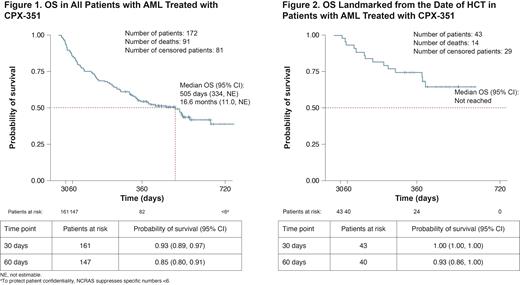Abstract
Introduction: CPX-351 (US: Vyxeos ®; Europe: Vyxeos ® Liposomal) is a dual-drug liposomal encapsulation of daunorubicin and cytarabine in a synergistic 1:5 molar ratio. Since November 2018, the National Institute for Health and Care Excellence (NICE) has recommended its use for adults with newly diagnosed, therapy-related AML (t-AML) or AML with myelodysplasia-related changes (AML-MRC) due to either prior myelodysplastic syndrome (MDS)/chronic myelomonocytic leukemia (CMML) or de novo AML with myelodysplasia-related cytogenetic changes. The key aims of this study were to utilize the Cancer Analysis System (CAS) database available through the National Cancer Registration and Analysis Service (NCRAS) to describe the demographics and clinical characteristics of adults with AML in England who have received CPX-351, as well as to estimate overall survival (OS) and survival within stratifications of interest.
Methods: The NCRAS systematically collects and curates population-level data about cancer diagnoses, treatments, and outcomes across England. Adults (aged ≥18 years) diagnosed with AML and treated with CPX-351 were included in this study. A diagnosis of t-AML or AML-MRC between January 2013 and March 2020 was determined either directly using International Classification of Diseases for Oncology, Third Edition (ICD-O-3) codes or indirectly using non-specific ICD-O-2, ICD-O-3, or ICD-10 AML codes in combination with either prior systemic anticancer therapy or radiotherapy (t-AML) or a prior diagnosis of MDS or CMML (AML-MRC; other AML-MRC subtypes could not be specifically identified and are included within the de novo AML subgroup). OS was measured from the date of diagnosis; a separate analysis of OS landmarked from the date of hematopoietic cell transplant (HCT) was also performed. Within this preliminary analysis, no OS adjustments have been made to account for any COVID-19-related deaths.
Results: A total of 172 patients with AML who were treated with CPX-351 were identified: 37 (22%) had t-AML, 57 (33%) had AML-MRC, and 78 (45%) had de novo AML. At diagnosis, the mean (standard deviation) age was 62.8 years (10.1), with 49/172 (28%) patients aged <60 years; 66% of patients were male; 87% were white; and most had an Eastern Cooperative Oncology Group performance status of 0 or 1 (68%). Six (3%) patients had received azacitidine treatment for a prior malignancy. To date, 43/172 (25%) patients had undergone HCT overall, including 43/97 (44%) patients with ≥3 months of follow-up.
The cut-off date for OS was December 31, 2020, giving a median (interquartile range) follow-up of 11.2 months (3.6, 16.9). Overall, 91 patients had died, with an estimated median OS (95% confidence interval [CI]) of 16.6 months (11.0, not estimable) and probability of survival (95% CI) at 1 and 2 years of 0.54 (0.47, 0.62) and 0.39 (0.30, 0.50), respectively (Figure 1). Early mortality rates were 7% at 30 days and 15% at 60 days. When OS was landmarked from the date of HCT, median OS was not reached, with a probability of survival (95% CI) at 1 year of 0.74 (0.62, 0.89; Figure 2). When stratified by age, estimated median OS (95% CI) was not reached for patients aged <60 years and 12.8 months (8.9, 17.6) for patients aged ≥60 years. In a treatment patterns analysis that evaluated second-line treatments after CPX-351, 68 patients died without salvage therapy and 64 were alive without receiving subsequent therapy by the end of the study period. The most common salvage treatments were fludarabine, cytarabine, idarubicin, and granulocyte-colony stimulating factor (FLAG-Ida; n = 15), daunorubicin plus cytarabine (DA)-based therapy (n = 6), and azacitidine alone (n = 7). Of the 43 patients who received an HCT, 6 (14%) underwent HCT following salvage therapy.
Conclusions: This is the largest study to date examining the real-world outcomes for patients with AML who were treated with CPX-351. The estimated median OS of 16.6 months is consistent with reported real-world outcomes for CPX-351 in French and Italian studies. Median OS has not been reached in patients aged <60 years or when landmarked from the date of HCT. Once the CAS database has been updated, these analyses will be repeated to increase follow-up and patient numbers and to determine the impact of COVID-19 on OS following CPX-351 treatment.
Legg: Jazz Pharmaceuticals: Current Employment, Current equity holder in publicly-traded company. Doubleday: IQVIA Inc., which was contracted by Jazz Pharmaceuticals for the conduct of this analysis: Current Employment. Reich: IQVIA Inc., which was contracted by Jazz Pharmaceuticals for the conduct of this analysis: Current Employment. Lambova: IQVIA Inc., which was contracted by Jazz Pharmaceuticals for the conduct of this analysis: Current Employment. Medalla: Jazz Pharmaceuticals: Current Employment, Current equity holder in publicly-traded company.


This feature is available to Subscribers Only
Sign In or Create an Account Close Modal